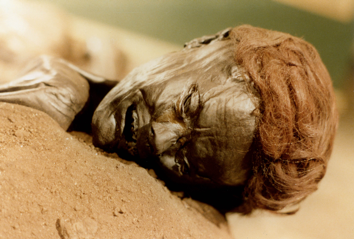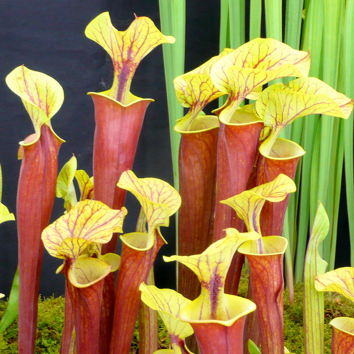Can you imagine being able to look at a body that is 2,700 years old and know what that person had for dinner? Many people are familiar with mummification, a form of corpse preservation. Probably the most famous type of mummification is the Egyptian process, a ritual that took 70 days. It required the removal of essential organs, dehydration steps to remove water, wrapping with gauze, and coating the corpse in a sticky wax called resin.1 The results of this intensive mummification process allow anthropologists to look at a corpse and get a good idea of what the person may have looked like when they were alive, but you can’t know what an Egyptian mummy ate for dinner. Bog bodies are a different matter.

The Northern European “bog bodies” are like a distant cousin to Egyptian mummies. Bog bodies are so well preserved that you can tell what season it was when they died, what they were wearing, how they died, and even what they ate for their most recent meal. These well-preserved remains allow anthropologists to understand Viking history, and give a snapshot in to the rituals that people may have performed thousands of years ago.2,3
Why are they called bog bodies? It turns out that the unique chemical environment found in bogs results in corpse preservation. Bogs are a unique ecosystem formed by the slow (thousands of years!) growth of vegetation on the surface of lakes or by water retention on dry surfaces by peat moss (sphagnum).4

Lakes and fresh water bodies are usually able to support animal life, like fish, because the water is constantly stirred which allows oxygen from the air to enter the water. In a bog, the water is still (stagnant) and oxygen cannot enter the water, so animals like fish cannot live there. The oxygen-free environment (called anaerobic) also prevents the growth of bacteria that decompose animal flesh.4 Some special species of bacteria can survive under bog conditions and degrade peat moss to form humic acids. This results in the bog being about as acidic as orange juice. Part of how the bog becomes acidic is that the outside of decaying moss takes up ions like calcium and magnesium from the water in exchange for hydronium ions, which are the chemical species that make things acidic.5 The acidity and low oxygen environment of a bog make it difficult for most plants to grow. Many of the plants that grow in bogs, like pitcher plants, are carnivorous and get their nutrients from eating bugs rather than from the soil.4 The ecology of bogs is unique, but how do the chemical conditions in the bog contribute to the tissue preservation of bog bodies?

The processes that preserve a body in a bog are very similar to what happens when we preserve leather (a process called tanning). In leather tanning, chemicals called tannins are used to preserve animal hides to make them more durable and resistant to decomposition. In the same way, tannins and sphagnan released from the peat moss preserve the tissues of a person buried in a bog by preventing bacterial growth.2,7 Also, tannins color the hair of the bodies red and darken the skin, and the bog naturally dehydrates the body.8 While the flesh of the corpse is very well preserved, calcium ends up being removed, which dissolves away the bones and teeth of the bog body.
I have always been fascinated by bog bodies because the unique chemistry and ecology tell us about history, excite morbid curiosity, and preserve the human expressions of people who lived at a time that otherwise can seem very, very distant. This natural “embalming” process has a remarkable effect on preserving corpses and allows anthropologists to generate interesting conclusions about the ways people lived in the past.2,7,9 For instance, anthropologists know that the Tollund Man ate a porridge of barley, flax seed, false flax, and knotgrass for his last meal. This suggests that he died in winter when there was less availability of fresh fruit and meat.10 Through bog bodies we can know what person had for dinner 2,700 years ago, while most of us can hardly remember what we ate for dinner last week!
EDUCATIONAL RESOURCES
- National Geographic – Bog Bodies: Haunting questions from the depths of Europe
- Caitlin Doughty. BOG MURDER MYSTERY (Morbid Minute), Ask a Mortician. Apr. 14, 2016 https://www.youtube.com/watch?v=RTy3gr1NeFI
REFERENCES
- Smithsonian anthropology outreach office. Eygptian mummuies. https://www.si.edu/spotlight/ancient-egypt/mummies
- Levine, Joshua. Europe’s famed bog bodies are starting to reveal their secrets. Smithsonian magazine. May, 2017. https://www.smithsonianmag.com/science-nature/europe-bog-bodies-reveal-secrets-180962770
- Editors of Encyclopaedia Britannica. Bog Body. Feb 18, 2015. britannica.com/science/bog-body
- Evers, Jeannie. Bog. National Geographic. Sept 12, 2012. nationalgeographic.org/encyclopedia/bog
- Priest, Susan. Orono bog walk. University of Maine. Feb, 2012. edu/oronobogwalk/wp-content/uploads/sites/393/2015/03/Peatland-Acidification-pH.pdf
- Engber, Daniel. Bless this Boggy Book. Slate. July 28, 2006. slate.com/articles/news_and_politics/explainer/2006/07/bless_this_boggy_book.html
- Stalheim, T.; Balance, S.; Chrustensen, B. E.: and Granum, P. E. Sphagnan – a pectin‐like polymer isolated from Sphagnum moss can inhibit the growth of some typical food spoilage and food poisoning bacteria by lowering the pH. Journal of Applied Microbiology. 2009, 106, 967-976. doi: 10.1111/j.1365-2672.2008.04057.x
- Calderone, Julia. Scientists keep finding ancient, well-preserved bodies in a creepy place. Oct 22, 2015. businessinsider.com/bog-bodies-science-preservation-sphagnan-peat-moss-2015-10
- The last meal. The Tollundman. http://www.tollundman.dk/sidste-maaltid.asp

Great Halloween post. Well written, keeps this non scientist interested. I do enjoy these blogs and I will take a few pitcher plants. I know what I had for dinner…Halloween candy.